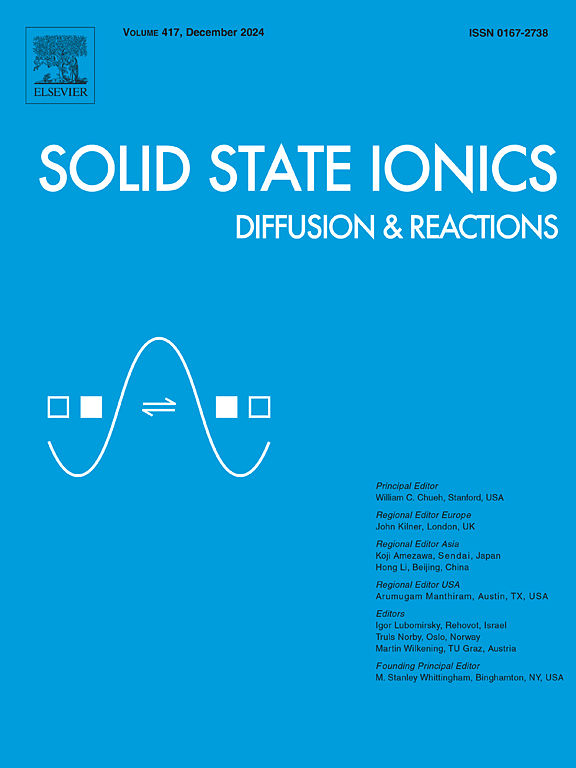具有多个阳离子取代的六方层状p2型相的钠离子电导率
IF 3.3
4区 材料科学
Q3 CHEMISTRY, PHYSICAL
引用次数: 0
摘要
现在人们普遍认为,固体电解质的电导率可以通过“高熵”(HE)效应得到显著提高。然而,HE电解质通常与它们的简单同构不同,其他因素会影响电导率:晶格膨胀/收缩、移动离子含量、键离子性、样品质量。为了将电导率的增强归因于HE效应,所有其他因素应该是相同的。这项工作比较了两种相关结构类型的“简单”和“HE”陶瓷钠离子导体:P2 Nax(MyTi1-y)O2和蜂窝状P2S Na2M2TeO6,具有相似的单元数据,x值,密度和纹理,并且没有显示任何可观的HE效应。特别是,新的Na2M2TeO6导体结合了3到5个二价M(来自Mg, Co, Ni, Cu, Zn),表现出与它们的单位类似物相似的电导率。p2型钛酸盐具有较高的电导率(373 K时为2-4 mS/cm),其原因是由于八面体阳离子尺寸较小以及x值降低的可能性而产生的几何效应。本文章由计算机程序翻译,如有差异,请以英文原文为准。

Sodium ion conductivity of hexagonal layered P2-type phases with multiple cationic substitutions
It is now widely assumed that conductivity of solid electrolytes may be markedly enhanced by the “high-entropy” (HE) effect. However, HE electrolytes usually differ from their simpler isomorphs by other factors affecting conductivity: lattice expansion/contraction, mobile ion content, bond ionicity, quality of samples. To attribute enhanced conductivity to the HE effect, all other factors should be identical. This work compares “simple” and “HE” ceramic sodium-ion conductors of two related structure types: P2 Nax(MyTi1-y)O2 and honeycomb-ordered P2S Na2M2TeO6, with similar unit cell data, x values, density, and texture and does not reveal any considerable HE effect. In particular, new Na2M2TeO6 conductors combining three to five divalent M (from the list Mg, Co, Ni, Cu, Zn) show similar conductivities with their monocation analogs. Higher conductivity of the P2-type titanates (2–4 mS/cm at 373 K) is explained by the geometrical effect due to smaller size of octahedral cations and possibility of decreased x values.
求助全文
通过发布文献求助,成功后即可免费获取论文全文。
去求助
来源期刊

Solid State Ionics
物理-物理:凝聚态物理
CiteScore
6.10
自引率
3.10%
发文量
152
审稿时长
58 days
期刊介绍:
This interdisciplinary journal is devoted to the physics, chemistry and materials science of diffusion, mass transport, and reactivity of solids. The major part of each issue is devoted to articles on:
(i) physics and chemistry of defects in solids;
(ii) reactions in and on solids, e.g. intercalation, corrosion, oxidation, sintering;
(iii) ion transport measurements, mechanisms and theory;
(iv) solid state electrochemistry;
(v) ionically-electronically mixed conducting solids.
Related technological applications are also included, provided their characteristics are interpreted in terms of the basic solid state properties.
Review papers and relevant symposium proceedings are welcome.
 求助内容:
求助内容: 应助结果提醒方式:
应助结果提醒方式:


